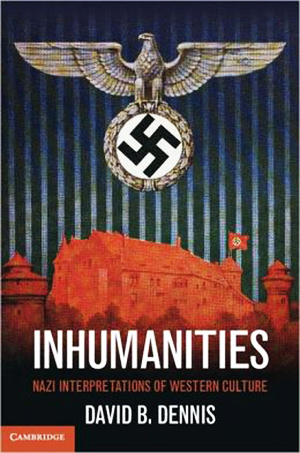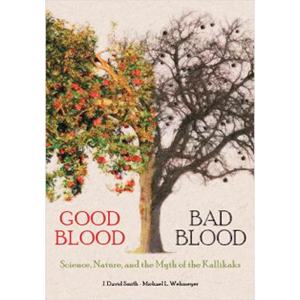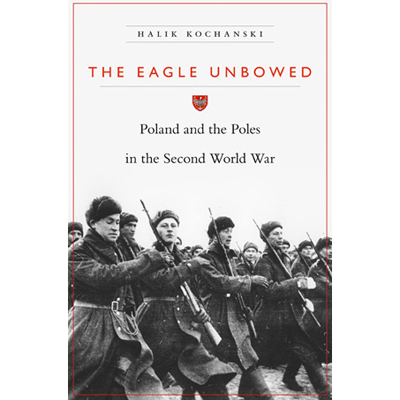 Inhumanities: Nazi Interpretations of Western Culture
Inhumanities: Nazi Interpretations of Western Culture
By David B. Dennis
Cambridge University Press; 2012
The staggering rise to power of the Nazis; the invasion of Poland and subsequent occupation of Eastern Europe; mass population transfers, settlement, deportation, and the legacy of the Holocaust; while all of these attest to the grandiose plans of Hitler to create a purely German living-space in East-Central and Eastern Europe, it is important to note that the philosophy of National Socialism originally began as a spiritual movement that sought to awaken the slumbering Germanic “racial-soul” to the dangers posed by the seemingly unrelenting advance of modernity and cosmopolitanism, both of which were ascribed by the Nazis to the Jewish race, and in particular, the role of the Jewish “racial-soul” in corrupting German society.
In his book, Inhumanities: Nazi Interpretations of Western Culture, David B. Dennis of Loyola University Chicago examines in depth the bulk of Nazi philosophical thought through the writings, editorials, cartoons, and art criticism within the Volkische Beobachter, the primary Nazi party organ which, between the years 1919 and 1945, sought to ascribe all advances in culture, the sciences, and the arts to the active intersession of a Germanic “racial-soul” onto the creativity of the artist and which likewise accused other artists of becoming spiritually corrupted or contaminated by the workings of the Jewish “racial-soul,” which according to the Nazis blurred concrete identities, tore down established boundaries, and eliminated cultural and racial distinctions by espousing a universal cosmopolitanism.
Dennis’ comprehensive translation of the Volkische Beobachter, much of which has not been translated to date, is beautifully summarized in 533 pages and which, divided into five sections, demonstrates the fervent desire of the Nazis to expropriate the cultural and literary “greats,” from Michelangelo and Goethe to Schiller and Shakespeare, as representative of the active workings of the Germanic “racial-soul” and in essence allow the Nazis to claim what Dennis describes as a sense of “cultural worthiness” (2).
Part one, The Foundations of Nazi Cultural History, describes in detail the belief among the Nazis that the major figureheads of the Western cultural canon derived their creativity precisely from their Aryan racial origins and sought to appropriate as “spiritual comrades” those figures who, though not necessarily German, represented the culmination of Aryan spiritual creativity. In illustrating the manner in which the Nazis drew distinctions between those deemed “Germanic-in-spirit” and those they condemned as racially and spiritually corrupted, Dennis describes the perpetual conflict that the Nazis saw between what they termed Kultur—consisting of the Volk, which is to say a community of blood, race, and cultural tradition to which all members owe deference and allegiance—with Zivilization, a term which bore connotations of liberalism, commerce, materialism, and which, in espousing notions of equality and universal citizenship, was seen by the Nazis as the threat to the racial and spiritual integrity of the Volksgemeinschaft, or Volk community.
Thus, in keeping with the continuity of race and creativity, Michelangelo, despite his Italian background, was declared by Nazi theorist Alfred Rosenberg as “one of the great men of the Nordic West” due to the manner in which his artwork espoused action rather than intellectual contemplation and therefore the “dynamic Germanic nature” based upon, in thematic parallel with Nietzsche, a continuous struggle to overcome the world (18). Likewise, the Dutch artist Rembrandt was characterized as “restless [and] ever-searching,” whose art had no patience for “stagnation of the soul” and sought to render the “invisible visible” (22), a key thematic among Nazi intellectuals, who identified abstract, intellectual art as reflective of the racially “impure” soul of the artist and who emphasized clarity, forthrightness, raw emotion, and permanence as characteristics of the Aryan. Finally, Shakespeare, who had been described by Hitler Youth leader Baldur von Shirach as the equal of Goethe and a “fighter for bravery and loyalty” (23) was used incessantly by the Nazis who, in taking from The Merchant of Venice, sought to illustrate the spiritual incompatibility as well as establish the eternal historic conflict between Aryans and Jews.
Part two, Blind to the Light, and part three, Modern Dilemmas, continue the chronological path that Dennis sets out towards the eighteenth and nineteenth centuries, where he demonstrates the Nazi rejection of “proto-modernist” thought among the Enlightenment thinkers, whose ideas are instead rooted in the nationalist and romanticist traditions. In its treatment of Goethe for instance, the Volkische Beobachter sought to downplay any association between the German poet and his reputation as a “citizen of the world,” which was denounced by the paper as a “liberal-leftist ploy,” and instead characterized Goethe as deeply connected to his homeland and which spared no opportunity to denounce the “cosmopolitan” and “bourgeois” nature of Goethe’s contemporaries (68). In reference to the wars of liberation taking place against Napoleon’s armies, Goethe was characterized by one editor as “deeply regretted [for] not belonging to a great, strong, respected, and feared Volk for which national honour is not a dream…embattled by internationalist utopians without character” (69) while the author Hans Johst described Goethe’s Germanness as characterized through his “impulsive idea of expansion and sense of mission” as opposed to the “global drivel” of the “internationalist utopian view of humanity” (70).
Similar to Goethe, Frederick Nietzsche, a monumental figure whose reputation had been greatly affected by his later appropriation by Nazi theorists, was used as a major cultural authority by the editors of the Volkische Beobachter, in particular, his theory of the Ubermensch, which was used to justify German racial superiority. Ignoring the fact that Nietzsche eschewed biological determinism, favoring instead the cultivation of a worthy “spiritual aristocracy,” editor Jozef Stolzing, in response to Nietzsche’s popularity among the “international-democratic literati,” wrote that “Nietzsche hated and fought every form of democracy, both political and spiritual,” and in regards to notions that all men are at base the same, that “the weak, fat, and cowardly were symbols of this equality” and that Nietzsche considered “the rule of the humble amounted to a blow against life itself: the herd instinct—the mass mentality—[that] considered peace to have higher value than war” (254).
Part four, ‘Holy’ War and Weimar ‘Crisis,’ traces the story of the Volkische Beobachter in that tumultuous time following the First World War called the Weimar Republic which, up until the assumption of power by Hitler in 1933, was the period that saw the genesis of several cultural “greats” including author Thomas Mann and playwright Bertold Brecht, as well as the appearance of new art forms such as Dadaism that would later be put on display during the 1937 Degenerate Art Exhibition (Entartete Kunst Ausstellung) as evidence of the racial and spiritual corruption of artists who produced such art. The threat of Bolshevism is threaded throughout Nazi commentary at the time, which understood communism not simply as a military or material threat but as seeking to subvert and overturn all existing social relations. While artworks such as that of Pablo Picasso or George Grosz reflected the moral wasteland in the aftermath of the war, the Volkische Beobachter railed against what it called “art bolshevism” and attacked everything from the “hooting, moaning, and whining [of] atonal negro music” (269) to the lack of definition and idealism in modern art, which was overly intellectual and lacked the Sehnsucht, or “longing,” that was said to characterize the eternal nature of the Aryan soul.
It is in this section, as well as in Part five, Nazi “Solutions,” that it becomes more apparent how the Volkische Beobachter assumed its full function as a Kampfblatt, or “combat paper,” in which all of the literary figures of German and European history were used to justify the overthrow of the Weimar republic as necessary as an impediment to the rebirth or “awakening” (Erwachung) of the German people as well as the necessity of war. Following the release of the 1929 film based on Erich Maria Remarque’s All Quiet on the Western Front, which takes a critical look at the seemingly senseless killing that the war engendered, the Volkische Beobachter published article after article invoking the spirit of Goethe, of Nietzsche, or of Wagner, in denouncing what it called the “asphalt literati…[those] enemies of the Volk, those who scorn anything heroic” (241), in order to help mobilize the youth of Germany to take up arms for the Reich.
It is clear that through its appeal to literature and to high culture, the Volkische Beobachter sought both to claim cultural legitimacy as well as appear legitimate to Germany’s middle classes, many of whom agreed with the views presented in the paper. In the chaotic aftermath of the First World War when the paper was first published, Germans no doubt sought explanation for the moral and economic collapse of their nation in the wake of the war and Dennis describes Hitler’s self-image as an artisan forming a concrete, immutable, and eternal image of Germany built upon the shoulders of the timeless masters and in opposition to the considerable chaos that engulfed Germany during the Weimar era. Dennis also shows us the extent to which the Nazis went to create a cultural mythology that legitimized their takeover and which also provides fantastic insight into how totalitarian regimes rely on myths to justify and rationalize their actions. Inhumanities provides us a glimpse of Nazi totalitarianism that is seldom discussed; the fervent work of academics, newspaper editors, journalists, and authors, people who are often identified at the forefront of combating tyranny, as the primary originators and disseminators of National Socialism, and which should also draw our attention to the politically-motivated distortions, embellishments, and omissions in media today.
CR




Pingback: Review in Cosmopolitan Review | Inhumanities